
Grevillea excelsior, commonly known as flame grevillea or yellow flame grevillea, is a species of flowering plant in the family Proteaceae and is endemic to the south-west of Western Australia. It is an erect shrub or small tree with usually divided leaves with linear lobes, and clusters of orange flowers.
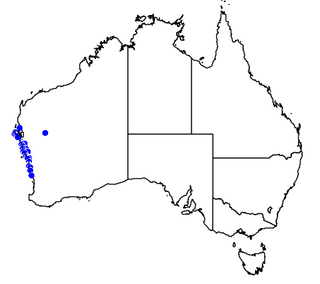
Commersonia borealis is a species of flowering plant in the family Malvaceae and is endemic to the southwest of Western Australia. It is a low growing, spreading shrub with egg-shaped to oblong leaves, and white, yellow and cream-coloured flowers.

Melaleuca depressa is a plant in the myrtle family, Myrtaceae and is endemic to the south-west of Western Australia. It is a small, bushy shrub with clusters of yellow or cream flowers on the ends of its branches in spring.
Grevillea eremophila is a species of flowering plant in the family Proteaceae and is endemic to the south-west of Western Australia. It is an erect shrub with leathery, linear to narrowly egg-shaped leaves with the narrower end towards the base, and creamy-white flowers.
Grevillea incurva is a species of flowering plant in the family Proteaceae and is endemic to inland south-western Western Australia. It is an erect shrub with linear adult leaves and clusters of creamy-yellow flowers.
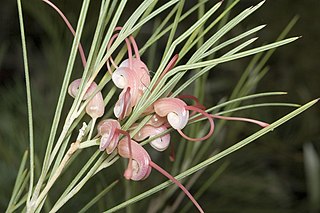
Grevillea oncogyne is a species of flowering plant in the family Proteaceae and is endemic to inland areas of Western Australia. It is an erect to spreading shrub with linear, sometimes lobed leaves, and clusters of red or pinkish red flowers.
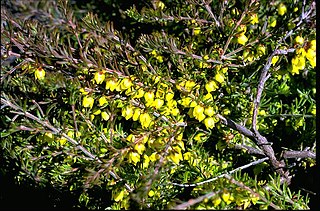
Boronia purdieana is a plant in the citrus family, Rutaceae and is endemic to the south-west of Western Australia. It is a shrub with pinnate leaves and yellow, four-petalled flowers arranged singly in leaf axils.

Leucopogon tamminensis is a species of flowering plant in the heath family Ericaceae and is endemic to the southwest of Western Australia. It is a slender shrub with many branches, overlapping triangular to egg-shaped leaves and white, tube-shaped flower arranged singly in upper leaf axils.

Philotheca deserti is a species of flowering plant in the family Rutaceae and is endemic to inland Western Australia. It is an erect shrub with narrow spindle-shaped, glandular-warty leaves and white flowers arranged singly in leaf axils.

Philotheca tomentella is a species of flowering plant in the family Rutaceae and is endemic to the south-west of Western Australia. It is an undershrub with small club-shaped to cylindrical leaves and white flowers with a pale red central stripe, arranged singly or in groups of up to four on the ends of branchlets.
Goodenia eremophila is a species of flowering plant in the family Goodeniaceae and is endemic to inland areas of Western Australia. It is an ascending herb with linear to elliptic leaves and thyrses of blue flowers.
Goodenia nuda is a species of flowering plant in the family Goodeniaceae and is endemic to the Pilbara region of Western Australia. It is an erect to ascending herb with elliptic to lance-shaped leaves at the base of the plant, and racemes of yellow flowers.
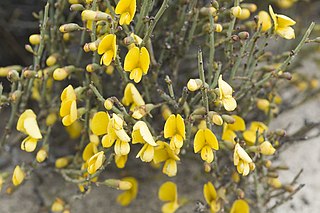
Bossiaea leptacantha is a species of flowering plant in the family Fabaceae and is endemic to southern Western Australia. It is a low, compact, spreading, many-branched shrub, the branches ending in cladodes, the leaves reduced to small scales, and with deep yellow, red and greenish yellow flowers.
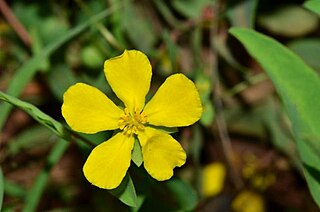
Hibbertia silvestris is a species of flowering plant in the family Dilleniaceae and is endemic to the south-west of Western Australia. It is a prostrate to more or less erect or spreading shrub with hairy young branchlets, elliptic to egg-shaped leaves with the narrower end towards the base and yellow flowers with seven to ten stamens on one side of two softly-hairy carpels.
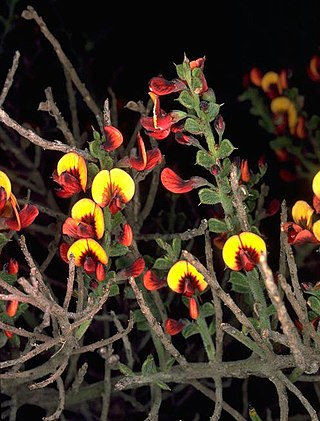
Daviesia dielsii, commonly known as Diels' daviesia, is a species of flowering plant in the family Fabaceae and is endemic to the south-west of Western Australia. It is on intricately-branched shrub with sharply-pointed, egg-shaped, vertically compressed phyllodes, and yellow and red flowers.
Grevillea ceratocarpa is a species of flowering plant in the family Proteaceae and is endemic to inland areas of the south-west of Western Australia. It is an erect or spreading shrub with softly-hairy, narrowly elliptic or narrowly egg-shaped leaves with the narrower end towards the base, and creamy-white flowers.

Lechenaultia stenosepala, commonly known as narrow-sepaled leschenaultia, is a species of flowering plant in the family Goodeniaceae and is endemic to the south-west of Western Australia. It is an open, more or less erect perennial herb or shrub with crowded, narrow leaves, and blue to pale blue or creamy-white flowers.
Lasiopetalum microcardium is a species of flowering plant in the family Malvaceae and is endemic to the south-west of Western Australia. It is a low, spreading or straggling shrub with hairy stems, heart-shaped leaves and blue, purple or white flowers.
Pimelea gilgiana is a species of flowering plant in the family Thymelaeaceae and is endemic to near-coastal areas of north-western Western Australia. It is a shrub with narrowly egg-shaped leaves and head-like clusters of white or pinkish, dioecious flowers.
Ricinocarpos stylosus is a species of flowering plant in the family Euphorbiaceae and is endemic to the Norseman district of Western Australia. It is an spreading, rounded, monoecious or dioeceous shrub or small tree, with linear to narrowly oblong leaves and female flowers arranged singly, or with two to five male flowers, or a single female flower surrounded by up to four male flowers.














